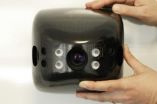(Press-News.org) Like a well-rehearsed formation team, a flock of flying robots rises slowly into the air with a loud buzzing noise. A good two dozen in number, they perform an intricate dance in the sky above the seething hordes of soccer fans. Rowdy hooligans have stormed the field and set off flares. Fights are breaking out all over, smoke is hindering visibility, and chaos is the order of the day. Only the swarm of flying drones can maintain an overview of the situation. These unmanned aerial vehicles (UAVs) are a kind of mini-helicopter, with a wingspan of around two meters. They have a propeller on each of their two variable-geometry side wings, which lends them rapid and precise maneuverability. In operation over the playing field, their cameras and sensors capture urgently-needed images and data, and transmit them to the control center. Where are the most seriously injured people? What's the best way to separate the rival gangs? The information provided by the drones allows the head of operations to make important decions more quickly, while the robots form up to go about their business above the arena autonomously – and without ever colliding with each other, or with any other obstacles.
A CMOS sensor developed by researchers at the Fraunhofer Institute for Microelectronic Circuits and Systems IMS in Duisburg lies at the heart of the anti-collision technology. "The sensor can measure three-dimensional distances very efficiently," says Werner Brockherde, head of the development department. Just as in a black and white camera, every pixel on the sensor is given a gray value. "But on top of that," he explains, "each pixel is also assigned a distance value." This enables the drones to accurately determine their position in relation to other objects around them.
Sensor has a higher resolution than radar
The distance sensor developed by the IMS offers significant advantages over radar, which measures distances using reflected echoes. "The sensor has a much higher local resolution," says Brockherde. "Given the near-field operating conditions, radar images would be far too coarse." The flying robots are capable of identifying even small objects measuring 20 by 15 centimeters at ranges of up to 7.5 meters. Moreover, this distance information is then transmitted at the very impressive rate of 12 images per second.
Even when there is interfering light, for example when a drone is flying directly into the sun, the sensor will deliver accurate images. It operates according to the time-of-flight (TOF) process, whereby light sources emit short pulses that are reflected by objects and bounced back to the sensor. In order to prevent over-bright ambient light from masking the signal, the electronic shutter only opens for a few nanoseconds. In addition, the sensor also takes differential measurements, in which the first image is captured using ambient light only, a second is taken using the light pulse as well, and the difference between the two determines the required output signal. "All of this happens in real time," adds Brockherde.
The 3D distance sensors are built into cameras manufactured by TriDiCam, a spin-off company of Fraunhofer IMS. Jochen Noell, TriDiCam's managing director, admits: "This research project has presented us with new challenges as regards ambient operating conditions and the safety of the sensor technology." The work falls under the AVIGLE project, one of the winners of the 'Hightech.NRW' cutting-edge technology competition which receives funding from both the Land of North Rhine-Westphalia and the EU. The IMS engineers will be presenting their sensor technology at the Fraunhofer CMOS Imaging Workshop in Duisburg on June 12 and 13 this year.
Conducting intelligent aerial surveillance of major events is not the only intended use for flying robots. They could also be of benefit to disaster relief workers, and likewise to urban planners, who could utilize them to produce detailed 3D models of streets or to inspect roofs in order to establish their suitability for solar installations. Whether deployed to create virtual maps of difficult-to-access areas, to monitor construction sites or to measure contamination at nuclear power plants, these mini UAVs could potentially be used in a wide range of applications, obviating the need for expensive aerial photography and/or satellite imaging.
INFORMATION:
Flying 3-D eye-bots
2012-05-04
ELSE PRESS RELEASES FROM THIS DATE:
Black hole caught in a feeding frenzy
2012-05-04
When it comes to scary things in the universe, it's hard to get much scarier than supermassive black holes. These gigantic, invisible menaces lurk in the centers of galaxies, hungrily vacuuming up everything within reach - or so we think. But the truth is more benign. Supermassive black holes snack infrequently, making the recent discovery of a black hole in the act of feeding all the more exciting to astronomers.
"Black holes, like sharks, suffer from a popular misconception that they are perpetual killing machines," said Ryan Chornock of the Harvard-Smithsonian Center ...
Researchers discover first gene linked to missing spleen in newborns
2012-05-04
NEW YORK (May 3, 2012) -- Researchers at Weill Cornell Medical College and Rockefeller University have identified the first gene to be linked to a rare condition in which babies are born without a spleen, putting those children at risk of dying from infections they cannot defend themselves against. The gene, Nkx2.5, was shown to regulate genesis of the spleen during early development in mice.
The study, published online May 3 in Developmental Cell, raises the hope that a simple genetic screening test for Nkx2.5 mutations can be developed that will alert parents that their ...
Jumeirah's First European Resort is Now Open
2012-05-04
Jumeirah Group, the global luxury hospitality company and a member of Dubai Holding, has celebrated the opening of its first European resort.
Nestled on the bay of Soller in Mallorca, Spain, Jumeirah Port Soller Hotel & Spa is the latest addition to Jumeirah's portfolio of luxury spa hotels and the five-star resort is ideal for travellers who want to discover the local traditions, connect with the destination and enjoy an internationally recognised service.
Strategically located in the northwest of the island of Mallorca, Puerto de Soller is a small fishing village ...
A needle in a haystack: How does a broken DNA molecule get repaired?
2012-05-04
Scientists from the Kavli Institute of Nanoscience at Delft University of Technology have discovered a key element in the mechanism of DNA repair. When the DNA double helix breaks, the broken end goes searching for the similar sequence and uses that as a template for repair. Using a smart new dual-molecule technique, the Delft group has now found out how the DNA molecule is able to perform this search and recognition process in such an efficient way. This week, the researchers report their findings in Molecular Cell.
A staggering problem
Sometimes, the DNA double helix ...
Research Now Launches Valued Opinions 2.0 in Australia
2012-05-04
Research Now, the leading global online sampling and data collection company, today announced the gradual launch of its improved Valued Opinions programme to over 200,000 active members in Australia. Enhancements include: a modernised website and new identity; increased member communications and support resources; access to a complete history log; social media integration; the introduction of quick polls; a greater variety of rewards; and a complimentary Smartphone app.
Since its first launch in the United Kingdom in April 2011, Valued Opinions 2.0 has seen a 25-30 ...
Fast, low-power, all-optical switch
2012-05-04
An optical switch developed at the Joint Quantum Institute (JQI) spurs the prospective integration of photonics and electronics. What, isn't electronics good enough? Well, nothing travels faster than light, and in the effort to speed up the processing and transmission of information, the combined use of light parcels (photons) along with electricity parcels (electrons) is desirable for developing a workable opto-electronic protocol.
The JQI (*) switch can steer a beam of light from one direction to another in only 120 picoseconds (120 trillionths of a second), ...
funK shades Expands Children's Sunglass Line With New Shades & Bright Spring Colors
2012-05-04
funK shades, the first makers of polarized children's sunglasses with snap-on charms, is bringing vivid spring colors and fashion-forward new styles to their Spring/Summer collection. With everything from chic neon pinks to breezy ocean blues, funK shades are 100% UVA UVB polarized lenses protecting children's eyes from harmful UV rays with both style and funKtion.
Just in time for summer, funK shades have added fashionable flair to its already adorable line of children's sunglasses. The new folding Wayfarer inspired frames are portable, compact, and perfect to endure ...
Scientists core into California's Clear Lake to explore past climate change
2012-05-04
University of California, Berkeley, scientists are drilling into ancient sediments at the bottom of Northern California's Clear Lake for clues that could help them better predict how today's plants and animals will adapt to climate change and increasing population.
The lake sediments are among the world's oldest, containing records of biological change stretching back as far as 500,000 years.
The core drilling is part of a unique, multifaceted effort at UC Berkeley to determine how Earth's flora and fauna responded to past changes in climate in order to improve models ...
Blacks and Hispanics at higher risk for precancerous colorectal polyps
2012-05-04
New York, NY (May 3, 2012) — Blacks and Hispanics have a significantly higher risk of developing precancerous colorectal polyps compared with whites, according to a study by researchers at NewYork – Presbyterian Hospital/Columbia University Medical Center. The findings appeared in the online edition of Alimentary Pharmacology and Therapeutics.
"Our data suggest that we need to redouble our efforts to increase colon cancer screening in areas with large numbers of racial and ethnic minorities," said lead author Benjamin Lebwohl, MD, MS, assistant professor of clinical medicine ...
New UF study shows early North Americans lived with extinct giant beasts
2012-05-04
New York, NY (May 3, 2012) — Blacks and Hispanics have a significantly higher risk of developing precancerous colorectal polyps compared with whites, according to a study by researchers at NewYork – Presbyterian Hospital/Columbia University Medical Center. The findings appeared in the online edition of Alimentary Pharmacology and Therapeutics.
"Our data suggest that we need to redouble our efforts to increase colon cancer screening in areas with large numbers of racial and ethnic minorities," said lead author Benjamin Lebwohl, MD, MS, assistant professor of clinical medicine ...



